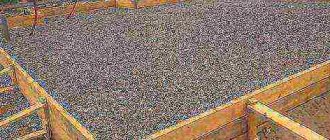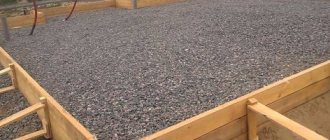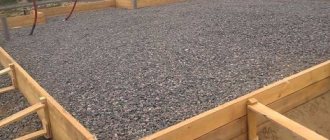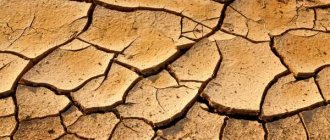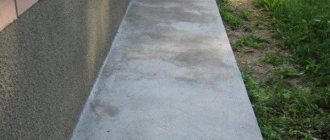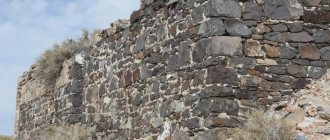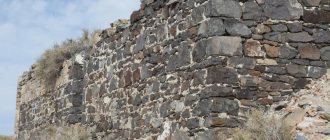In general, there are four main functions of this entire event:
- Crushed stone increases the support area; being under the foundation, it transfers the weight of the house to the ground. Thanks to the larger support area, the risk of foundation subsidence deep into the soil is reduced.
- The compaction process is of higher quality. Due to what? And due to the fact that the bottom of the pillow consists of many individual pebbles, which, when loaded, sink very well into the soil, thereby compacting it. Many people have probably noticed that if you take a pebble out of the ground, there will be very hard soil underneath it.
- A crushed stone cushion conducts water well, preventing it from lingering.
- Eliminates capillary effect. Sand can, due to the capillary effect, lift moisture from the depths from the ground to the base of the foundation. And the crushed stone cushion cuts off the layer with capillaries.
Crushed stone cushion for the foundation. Why is this bedding needed?: 5 comments
Author, do you think it’s possible to compact crushed stone normally when laying it in a trench? Of course not, but over time this whole thing will sag and the house will fall apart.
There is no need to exaggerate, crushed stone has been used in construction for a long time and no one’s house has ever fallen because of it. And the advantages of such a pillow are obvious.
It is possible and necessary to compact the crushed stone and pour it with a rare solution.
And what will happen? And what is a rare solution? Maybe skinny? All this useless blah blah blah, everyone will puff out their cheeks and give out the ultimate truth. Are you tense? Well, take a breath... And then decide: 1. The geology under the object 2. The planned characteristics of the object 3. The area where construction is planned. Maybe it’s the tropics in the Yamalo-Nenets Autonomous Okrug, or frost heaving in Sochi. Or maybe they put a slab under the frame...
Basic requirements for the correct crushed stone for the foundation
The choice of crushed stone and its use directly affects the strength of the base and its resistance to the external environment. Therefore, it is important to follow some construction tricks and recommendations.
- Do not use recycled crushed stone; you can add pieces of brick or recycled crushed stone to the mass, but not more than 10% of the mass!
- Only quarry or mountain crushed stone; sea gravel is not suitable for these tasks. It has a rounded, smooth surface that does not provide the necessary adhesion to the cement mass.
- Crushed stone for the foundation should not have harmful impurities - garbage, clay, construction waste - the strength of the foundation is impaired and there will be cracks.
- When choosing a material, it is important to choose a cube-shaped type of crushed stone - this is the option that will allow you to achieve the highest density of the concrete mass. Other forms, even with sufficient compaction, give shrinkage and voids.
- After pouring the foundation, it must stand, and it must be watered daily. The surface of the base must be covered with something to prevent cracking in the sun - slate, roofing felt, boards.
- Crushed granite has an increased radioactive background; if the choice falls on it, it is important to know the background level of a given batch, which is indicated in the accompanying documents from the seller.
Post navigation
Where can I get money to complete the renovation?
In general, you have practically no money left, but the repairs need to be completed, the situation is standard.
Three options come to mind:
- Start saving and put off finishing what you have started indefinitely;
- Borrow money from relatives (friends). It’s not a fact that they will give it))
- Take a loan. Again, it’s not a fact that they will give it if you’re already deeply in debt. Well, paying interest is also not pleasant.
Well, the actual life hack is to apply for an online “Halva” card from Sovcombank with an interest rate of 0% and an installment limit of 350 thousand rubles.
They will even bring the card directly to your home.
I didn’t come up with the 0% rate, it’s the bank itself that provides such conditions, so all questions should be addressed to them. If you don't believe me, see for yourself.
Types of pillows
How to make a foundation cushion for a certain type of soil?
There are three types of pillows: sand, crushed stone and combined gravel-sand.
The sand cushion can be installed under a strip foundation. The sand should be coarse-grained or medium-grained.
On weak-bearing soil, a sand-crushed stone cushion is installed. The ratio of such a tandem should be: sand - forty percent, crushed stone - sixty percent. The crushed stone cushion does not shrink after it has been laid and can easily withstand the weight of a wooden house, even without reinforced compaction. If you plan to build heavier buildings, then compacting such a cushion is mandatory.
Filling with crushed stone to restore roads
You can fill the road with crushed stone when it is being restored. If a major overhaul of the road surface is carried out, the layers are completely changed. Which crushed stone is best for filling a road? Large material (40-70 mm) is used for the first layer. Then crushed stone of large grains with a size of 20-40 mm is used. A fine-grained layer corresponding to a fraction size of 5-20 mm is poured on top of the road surface on top of a cuboid-shaped grain of 20-40 mm.
The quality of the coating largely depends on the correct compaction of the crushed stone layers. Each embankment is leveled and then compacted using special equipment. The use of road rollers is not required; hand tampers, tamper plates, lattice or pad rollers are used. At the final stage, the surface is rolled using machines on pneumatic tires weighing up to 25 tons.
Using crushed stone to make a pillow
It is very difficult to imagine at least one construction site that could do without crushed stone. This building material is very difficult to replace with anything else. It is obtained by crushing mountain stones, boulders, and gravel.
Crushed stone comes in different types:
- Gravel - has high strength, low background radiation. It is obtained by sifting rocks and crushing stones using specialized equipment. It has a low cost.
- Granite is a high-strength type, used mainly in civil engineering, easy to process and can withstand heavy loads. It is obtained by processing natural granite, which is mined by blasting rocks. It is ideal for the production of reinforced concrete blocks and pouring foundations. But it has a minor drawback: it accumulates radiation. Of course, the accumulations are not significant and are not at all dangerous to human health.
- Limestone is the cheapest type of crushed stone. It has lower quality characteristics compared to the two previous types. It is obtained from limestone rocks and is resistant to low temperatures.
Benefits of use
The use of crushed stone backfill has its positive aspects:
- Construction material is readily available. You can find it in almost every region;
- The cost of crushed stone compared to other materials is significantly lower, which makes construction cheaper;
- Installation of the pillow is simple and does not require special construction equipment. Often, backfilling is done manually along with preparing the construction site for laying the foundation;
- The substrate allows you to compensate for compressive loads arising under the weight of the structure being erected;
- Thanks to the presence of crushed stone bedding, heat loss from the foundation is reduced;
- Thanks to the use of certain sand fractions, a high degree of compaction is achieved. The strength of the structure increases significantly;
- Loads from the future building are evenly distributed;
- The presence of a substrate prevents moisture from rising to the base by capillary action;
- If construction is carried out on a site with uneven terrain, then the use of a cushion allows you to adjust the landscape to facilitate the construction of the foundation.
There are also disadvantages to using a substrate.
It is strictly prohibited to use a foundation cushion made of crushed stone for the construction of high-rise buildings located on soils with a groundwater level that is located close to the surface.
What crushed stone is suitable for creating a pillow?
The most common type of crushed stone for pouring under the foundation, having a fraction of twenty to forty millimeters. It is included in the first category of radioactivity and is absolutely safe for human health. Strength - M1200. It has frost-resistant characteristics, which is very convenient for compacting pillows from it.
If we consider a cheap option, then it can include secondary crushed stone, which is obtained by crushing old concrete.
In order for the building to stand for many years, and the foundation not to be modified, crushed granite stone is used. This is the most expensive option. But thanks to its characteristics, it will withstand any construction. Typically, granite crushed stone is combined with other building materials, most often with sand.
Types of roads in which crushed stone is used
Different types of road surfaces are filled with crushed stone:
- Ground;
- Country roads;
- Field;
- Automotive.
All these types of canvases must meet certain requirements.
Ground
Dirt road
- this is any road surface suitable for the movement of wheeled vehicles, but does not have a hard top surface. The roadway can be improved by introducing skeletal additives - slag, gravel, local binders - ash and slag mixtures, industrial waste.
Since they are laid on natural soil, during heavy rainfall and melting snow they often become unusable. Safety of movement along them is guaranteed only in dry weather, after the onset of frost.
When building a dirt road, it is necessary to take into account that two cars must pass on it without difficulty. The width is assumed to be at least 4 m. For a dacha canvas, two meters wide is enough.
Country
Country road
- This is a type of soil canvas. Most often it is not strengthened by anything; sometimes it can be leveled with a grader. On maps they are indicated by one continuous stripe.
Field
Field or forest - the result of natural rolling of soil by vehicles. It looks like two parallel tracks. Such a surface is often overgrown with grass. It is marked on maps as a broken line.
Highways belong to the category of engineering structures. They have two or multi-lane, oncoming and passing traffic directions.
The main elements of roads are:
- Roadbed is a strip of land that is intended for the movement of vehicles. Provides favorable driving conditions for vehicles of a certain weight, safe movement at a given speed limit, which does not depend on the time of day, weather conditions, or seasonality.
- Right-of-way is a part of the area along the road surface where road elements and structures are located.
- Subgrade is a specially prepared soil mass. The roadway is located on it, the drainage system is being constructed, side ditches and shoulders are placed.
- Road pavement – special reinforcement of the roadway. Designed to ensure the movement of vehicles of a certain weight at the permitted speed. It is resistant to the adverse effects of climatic factors.
- Curbs – two lanes along the edges of the roadway. Adjacent directly to the roadway. Designed for support on the sides of road surfaces and for short-term parking.
- Side ditches are ditches on both sides of an earthen embankment. They serve to remove moisture and dry the roadway.
- Brovka - the border at the intersection of the roadside and the earthen slope.
- Edges are sections of the right-of-way that are located outside the subgrade. In total they are used for green spaces and linear buildings.
Highways are classified according to their significance - federal, regional, local, private.
How to make a pillow from crushed stone
A crushed stone cushion for the foundation is used in the construction of large country houses and cottages, and it does not matter what material the building is built from.
Before starting construction work, the base should be covered with finer material. As it, you can use river sand of medium or large size. It does not contain organic substances that can decompose and rot over time. Therefore, it can be used without additional processing. The sand mound should be from ten to fifteen centimeters. After which it needs careful uniform distribution and compaction. If this requirement is not met, the surface may turn out to be uneven, and it is unlikely that this defect will be corrected later.
Only after creating a preliminary layer can crushed stone be poured, the layer of which should vary from twenty to twenty-five centimeters. It, like the sand layer, needs to be well leveled and compacted using a vibrating plate or tamping roller.
If you don’t have such devices in your arsenal, you can make such a tool yourself. To do this you need a log about one meter in size. Two handles are screwed to it, after which the end part of the log is drawn across the entire area of the future foundation. This process is easy to use, you just need to throw a log and when it falls, the sand and crushed stone flooring will be compacted.
This layer will be the beginning of the foundation.
Next, it is necessary to continue work on creating the foundation. The crushed stone layer is covered with mortar. It can be sand-cement, lime-cement, cement-clay. The foundation is laid on a ready-made crushed stone layer. The height is usually chosen from fifteen to twenty centimeters from ground level. The masonry, in this case, can consist of brick or rubble stone. The masonry is reinforced with steel wire. This action is performed to enhance the reliability and strength of the foundation.
Sometimes a pillow is created only from crushed stone. But this only happens if the soil on which the building will stand is sandy. The technology is identical to laying a sand-crushed stone cushion. In addition, the crushed stone base fits perfectly under the foundation, in this case the durability of the foundation is ensured for many years. Crushed stone can easily become a substitute for sand, and its use is indispensable on problematic soils where pouring a foundation is very difficult.
Construction of a dacha parking area: preparatory work
Despite the different surfaces for parking a car at the dacha, the preparatory work is not much different. The difference may be in the layer on which the coating is laid (for example, you need to pour a layer of sand when paving with paving slabs), but the whole pie and the list of other works are the same.
You can do this... until you get stuck after the rain
General recommendations
The first thing you need to decide on is the location. The parking lot at the dacha is usually located either right next to the gate or not far from it. And it makes sense. But this zone should not be the lowest point, otherwise water will constantly stagnate here, and a height difference here is also undesirable - putting the car on the handbrake and putting on chocks is not exactly what you want.
The best way to compact sand and gravel is to use a plate compactor. If you don’t have one, you can make a homemade tamper. Take a log, attach handles, and attach a strong platform (thick board) to the bottom. By lifting and sharply throwing this tool, you compact the sand/crushed stone
At the same time, solid surfaces such as concrete or asphalt should not be brought to zero level: water after washing a car or rain will not drain away. To prevent it from stagnating, it will be necessary to form a slight slope - from the center to the edges. A slope of a couple of degrees is already good. And the car will stand stable, and the water will drain.
Dimensions
The dimensions of a country parking lot depend on the planned number of cars “living” there. A plot of 3*5 meters is enough for one car, i.e. 15 m². This space is quite enough to not have to think about parking exactly in the center, otherwise you will have to go out onto the lawn, into a flower bed, etc. Parking at a dacha of such an area makes it possible to calmly walk around the car in front and behind.
If space is limited, the length can be reduced by 0.5 m, but with this size you can walk either in front of the car or behind it. Only if you have a large-sized jeep, it is better to increase the width of the platform by at least 50 cm, and even better - by a meter. These machines are large and require more space.
Parking lot sizes: this picture is from SNiP (building codes and regulations)
If you need to park two cars and they are “standard” sizes, the comfortable parking length at the dacha remains the same - 5 m. If there is enough space, we take the same width as 3 meters. That is, to park two cars you will need a site measuring 5*6 m (5 meters is the length). If there is a shortage of space, the width and length can be reduced by 0.5 meters (4.5 * 5.5). But in this case, it will not be possible to open the car doors at the same time and it will also be difficult to walk around the car.
Car entry: water drainage
The next step is to decide whether you need drainage around the parking lot at your dacha or not. If the soil drains water well naturally and the surface is not continuous (tiles, lawn, stone), it is quite possible to do without drainage measures. If at least one of the conditions is absent, drainage will have to be done. There are many options, but there are three simplest ones:
- If the water on the site usually does not stagnate, the perimeter of the site with a continuous coating (concrete, asphalt, rubber tiles) is sprinkled with crushed stone 30-40 cm wide. The water drains, enters the crushed stone floor and gradually goes into the ground.
If a drainage system is installed on the site, drainage pipes are laid around the perimeter (10 cm below the coating level, cover the top with crushed stone, pebbles, mulch, sand, plant a lawn). These pipes are inserted into the general drainage system (don’t forget to make a couple of inspection hatches for cleaning. Drainage of a parking area
- Install/fill storm drains around the perimeter and drain them into the storm drain.
When can you not think about draining water? When you have a sandy area or heavy rainfall is rare. Then there are no problems. Another option is a natural slope. In this case, the water will flow away by gravity, but you will still be solving the problem of storm drainage, only on the scale of the entire site.
With or without border
Any covering on the site for a car in the country will last longer if the area is fenced with a curb. In the case of a gravel or pebble parking lot, the curb will not allow the filler to scatter throughout the area. In the case of using paving slabs or stone, the presence of limiters can also be considered mandatory. They are laid on a sandy layer, and the sand can be washed away by rain streams.
Curbs are desirable for aesthetic and practical reasons
This will not happen if the parking lot at the dacha is at the same level or slightly lower than the rest of the site. But in this case, it will always be humid here and the water will not drain away, which obviously will not benefit your car. So the presence of a border is desirable - at least bury a brick around the perimeter, but then natural stone would be better. Or pour the concrete yourself, but it’s less troublesome to use ready-made curbs. For a budget option, you can use reinforced concrete grape columns.
Calculation of the amount of crushed stone and sand for the pillow
But how much crushed stone is needed for a pillow? Typically, a first layer of sand of both medium and coarse grains is laid under the foundation. The density of crushed stone should be from 2.0 - 2.7 g/cm³. There is no need to carry out preliminary work on leveling the trench, since the pad itself is part of the leveling layer. The thickness of the pillow should vary between ten and fifty centimeters, but may vary due to the load-bearing characteristics of the base. The pillow is poured in layers, each layer should be ten centimeters and very well moistened with water. Then compaction is carried out using a vibrating rammer.
The sand cushion is calculated using the formula. The first step is to calculate the depth of the foundation. But if the soil is problematic, then it is worth considering replacing it with sand. Next, the width of the fundamental surface is calculated.
There is a simpler way to calculate: To do this, measure the foundation. The width and length of the trench are multiplied. The result is once again multiplied by the total thickness.
You can make a pillow out of crushed stone with your own hands in other ways.
What fractions are used
Many fractions of crushed stone for a foundation cushion influence the choice:
- The composition of the soil is preliminarily determined. For example, black soil or sandstone shrink over time, which affects the stability of the foundation. As a result, the building becomes skewed and the risk of destruction increases. This leads to the conclusion that you need to use crushed stone of different sizes. In this case, two layers of bedding are made. If the construction site has stony or rocky soil, then the thickness of the crushed stone cushion under the foundation can be reduced, but the grade of crushed stone used is durable;
- The width of the substrate also has a dependence. In this case, it depends on the width of the base. As a rule, the ratio here is 1:3. If the foundation is strong and the groundwater is located far from the surface, then the width can be reduced. In this case, the width can be made from 110 to 125 percent relative to the foundation;
- If backfilling is carried out on the surface, then small gravel in the range of 10-15 mm is used.
- If the construction site is located on medium soils and when planning the construction of a building with a height of up to 5 floors, it is recommended to use crushed stone with a size of up to 40 mm, but not less than 20 mm;
- To give strength to the pillow, not only the filler in question is used, but also granite. In this case, the component fractions are up to 50 millimeters;
- It is better to add crushed stone obtained from crushed granite grades M800 - M1200 to the concrete mixture. Fractions from 20 to 60 millimeters.
Why do you need a pillow?
It would seem, why are foundation cushions needed if there is a dense layer of soil underneath as a base? But it turns out that it is thanks to them:
- uniform redistribution of incoming loads on the ground is maintained;
- point pressure decreases;
- the impact of frost heaving forces on underground structures is minimized;
- the bottom of the recess is leveled, and you can do this yourself;
- the horizontal position of the foundation base is guaranteed;
- groundwater level decreases, and rain and melt water is removed from the foundation;
- the stability of the position of the entire structure is ensured;
- shrinkage of various origins is minimized.
A stable foundation requires that the foundation pad be properly sized and adequately compacted and leveled. Its width should be greater than the width of the foundation sole, and its height should be selected taking into account:
- soil freezing depth;
- groundwater level;
- approximate magnitude of permanent and temporary loads;
- geological conditions.
The backfill under the foundation is a kind of ballast that protects the structure from contact with the soil and from seasonal soil movements.
Often a foundation cushion replaces an unsuitable or weak soil layer. In this case, it is removed, and coarse sand is added in its place. To prevent it from washing out or silting, when the groundwater level is high, geotextiles are placed in the excavation.
When constructing foundation cushions you can use:
- river and quarry sand;
- crushed stone and gravel;
- concrete solution.
Clarifications on the composition and size of the underlying layer are given in the design documentation. As a rule, it takes into account the availability of materials by region and their reasonable cost. But the main argument, nevertheless, remains geological conditions. For example, for soft soils, a gravel-sand cushion under the foundation is laid in the following proportions:
Some craftsmen offer the construction of a clay foundation cushion. They claim that the leveling layer will perform a waterproofing function. Of course, clay can protect concrete from capillary suction of water. But this soil is heaving, so when it freezes it increases in volume and begins to put pressure on the underground structure. From this it follows that the judgment that clay can be used for the foundation is absolutely incorrect.
Device and thickness
It is individual for each project, and for correct calculation several factors should be taken into account:
- What type of foundation is planned to be used?
- Dimensions and weight of the building.
- The soil on which the building is erected.
- Soil freezing depth.
- Presence and proximity of groundwater to the soil surface.
Many publications say that the thicker the sand layer, the better it resists various deformations of the structure. Experts strongly disagree with this opinion.
Important! The maximum thickness of the sand cushion for strip foundations is three strip widths.
For strip foundation
Strip foundation is the most common type of foundation used in the construction of low-rise buildings.
The thickness of the sand cushion under this type of foundation is determined based on the specific construction conditions. But for a small building, as a rule, they take an average value of 15-25 cm.
Experts recommend that the width of the sand cushion be 10-20 cm larger than the width of the tape.
A layer is made between the strip foundation and the soil as follows: the recommended layer of sand is poured onto the bottom of the trench and carefully leveled. After which the sand is moderately moistened with water for better shrinkage and subsequent compaction.
The process of compacting the layer is best done using a vibrating plate, but this can also be done with improvised means.
The degree of readiness can be determined as follows: there should be no traces of shoes left on the surface after the passage of an adult. After compaction, the stage of carefully leveling the pillow and laying a layer of waterproofing on it follows.
For a monolithic foundation
The arrangement of a sand layer under such a foundation is done in the same way as in a strip foundation, but over the entire area of the pit.
To make the correct layer for this type of foundation you need:
- Carefully level the bottom of the pit.
- Pour gravel or crushed stone 10-15 cm thick. This material serves to compensate for the low density of the soil and its heaving.
- A layer of sand is poured onto the crushed stone. For a small bathhouse or small cottage, a layer of 10 cm is enough. Sand will help to evenly distribute the load from the building on the soil.
- The next stage of the device will be thorough compaction. For this, experts recommend using a vibrating plate.
Before laying a foundation on it, the sand layer must be leveled and covered with a layer of waterproofing to prevent moisture from entering the foundation of the building.
For columnar and pile foundations
A columnar foundation also requires a sand layer underneath, or rather a sand and gravel layer.
The principle of its construction is the same as for other types of building foundations: first, a layer of gravel or crushed stone is poured, after which sand is poured, moistened and thoroughly compacted with a hand tamper.
For foundations of this type, the sand and gravel layer should be 20-30 cm thick. In addition, it should be 10-20 cm wider than the pillar on each side.
Afterwards, roofing felt or polyethylene is placed on the surface of the pillow to prevent water from being poured into it from being poured into the concrete.
sand cushion
It is better to make the underlying layer with your own hands from sand, since the material is quite available in many regions of the country. Inexperienced developers often have questions about what kind of sand is needed for the foundation and cushion - river or quarry, and what fraction of the grains should be.
We should start with the difference between river sand and quarry sand. The first is considered much cleaner, since the natural dislocation of the material and the technological features of extraction imply the absence of foreign particles in the composition. There are no clay inclusions that are too dangerous for the foundation structure. When mixing the concrete mixture and constructing a cushion for the foundation , it is better to use river sand or washed quarry sand, which will be somewhat cheaper.
Quarry sand is extracted in large quantities from open-pit mines. That is why it contains many different impurities, such as clay, large stones and dust particles. Without additional processing, it is used only in some cases, for example, when laying roads.
It is not recommended to use dirty quarry sand for the foundation and cushion, since the presence of even a small amount of harmful inclusions in it can adversely affect the stability of the underground part of the house and its durability. Why risk a one-time savings when there is a better quality alternative?
You can distinguish river bulk material from clean quarry sand by the appearance of the grains. You just need to look at them through a magnifying glass. In the first case, the particles will be round, and in the second - with sharp edges.
Sand for the foundation and pillows is chosen from large fractions.
As mentioned above, making a sand cushion for the foundation with your own hands will not be difficult at all. To do this you will need the material itself, a tamper and water. If the building area is large, it would be better to use a special vibrating plate or roller. And when compacting the underlying layer in a trench, you can use proven old-fashioned tools, for example, a log with a cross handle.
The sand cushion under the strip foundation or concrete slab is filled in layers. Each layer is leveled, moistened and thoroughly compacted. Abundant watering helps to better compact the sand and ensure maximum density of the base. When the groundwater level is high, crushed stone is added to the bottom of the trench. It takes on the functions of a drainage layer. In its absence, the foundation of the house will sooner or later be washed away.
Experts recommend making a foundation cushion from sand in cases where:
- a one-story house is being built;
- Light materials are used for the ground part of the structure;
- groundwater lies at great depths.
Even before starting work, you should decide on the thickness of the sand cushion for the foundation. As a rule, it is 10-20 cm, but when installing a base under a concrete slab or when replacing weak soil, the size can increase to 50-80 cm. For a strip structure, the maximum height of the underlying layer is limited by the triple thickness of the strip. As for the width of the pillow, it should be 20-25 cm larger than the same size of the sole or foundation slab.
Important characteristics of crushed stone
Crushed stone is used for foundations, road construction, decorative finishing of flower beds and much more.
Before choosing crushed stone, it is worth considering the following main characteristics:
- Strength. This indicator (grade) characterizes the material’s perception of mechanical loads (efforts). Identified by letter and numbers. To determine the characteristics, force is applied and a certain period of time is maintained. After such exposure, the percentage of mass loss is determined. Next, based on GOST, the value of the grade is determined, for example, M 200 or M 1400, that is, 200 MPa or 1400 MPa are indicators of the applied load that the material can withstand.
- Frost resistance. This indicator determines the number of freezing and thawing without loss of original properties. The specified quantity is indicated by the letter F with a digital indicator. Frost resistance grades range from F15 to F400, respectively, the higher the number, the higher the resistance to extremes.
- Flakiness. This indicator indicates the number of needle-shaped and flat particles in the stones, or the presence of irregularly shaped grains in the crushed stone. If there are a large number of these particles, then there are more voids inside the material, which is significantly noted during compaction. There are five groups of percentages of these components in total. For example, in I - 10% grains, and in V - up to 50%.
In addition to the important characteristics of the material, qualities such as adhesion should not be neglected; water absorption; water resistance; moisture release; clay content; dust particles and grains of soft rocks; indicator of bulk density and radioactivity.
Crushed stone bedding
The crushed stone cushion under the foundation is considered stronger than the previous version of the foundation. You can also do it yourself. At the initial stage, the bottom of the excavation is covered with a 10-15 cm layer of coarse sand, after which it is leveled and thoroughly compacted with moisture.
Next, crushed stone of the middle fraction (20-40mm) is laid in a layer 20-25cm thick. To compact it, use a vibrating plate. For what? Yes, only because it would be too labor-intensive to do it using old-fashioned methods.
A crushed stone cushion under a strip foundation is capable of absorbing loads from low-rise brick and stone houses.
Often the project provides for a crushed stone-sand foundation. It is filled in layers with alternating materials and compaction. This type of backfill has proven itself well in the construction of facilities on weak-bearing soils.
Types of country parking areas
The content of the article
[Collapse]
Dachas, and everyone’s requirements for comfort are different, and parking a car in a dacha offers more than a dozen options. There are only seven types of coverage, as well as their combinations and the possibility of installing canopies. They differ in operational characteristics and costs. So, the covering for parking a car in a country house can be of the following types:
- Made of crushed stone or pebbles (bulk).
- Lawn or eco-parking.
- From paving slabs.
Concrete. While you are not sure that you want one... parking at the dacha might be simpler
- Asphalt.
- Rubber tile.
- Flagstone.
- Parking grid.
Concrete base
The most expensive and reliable type of underlying layer. A concrete pad can even be used for the foundations of apartment buildings. The technology for its implementation is quite simple and accessible for independent work. The process consists of several stages:
- leveling the bottom of the excavation;
- adding crushed stone with a layer of 10 cm and tamping;
- installation of formwork to the height according to the project;
- waterproofing flooring;
- installation of reinforcement;
- pouring concrete mortar;
- gaining monolith design strength;
- dismantling formwork.
To ensure strong adhesion of the base to the foundation, steel rods protruding above the surface are installed in the cushion. They serve as connecting anchors, maximizing the strength of the underground structure.
Why is bulk material laid?
To briefly answer the question of whether it is always necessary to make a sand cushion under the foundation, the answer will be negative. Bulk material under the sole is needed to perform three functions, which are described below.
Block foundation
The construction of a sand cushion is an event inherited from Soviet times. At that time, the foundation of the house was mainly made from standard factory-made elements, FBS foundation blocks. According to SP 50-101-2004, for a prefabricated supporting part, preparation from bulk material is mandatory.
For a prefabricated foundation, the pillow acts as a leveling base.
The preparation from sand here is justified by the fact that when installing individual elements on the foundation soil, which has even slight differences, they may become distorted. The blocks are not interconnected enough and cannot cope with the uneven ground beneath them. It follows that the first function of the sand cushion under the foundation is the need to create a flat surface for the installation of individual elements. In addition, bulk material, unlike the soil available on the site, can easily adapt to the shape of the supporting part of the building and prevent its displacement during operation.
Monolithic concrete fills all uneven ground.
Heaving soils
Frost heaving is a phenomenon that frightens everyone who is involved in construction or who is planning to build a private house with their own hands.
It is important to understand the causes of this problem. It occurs when two factors are present simultaneously:
- water;
- low temperatures.
If you exclude at least one of them, heaving does not occur. Clay foundations are especially prone to this phenomenon. According to SP 50-101-2004, a cushion made of non-heaving (conditionally) materials (that is, of coarse-grained or medium-grained sand or coarse-grained material) is required to be provided for foundations constructed on heaving soils. In this case, only non-buried or shallow-buried supports are considered. Thus, the rise of water from the soil to the base of the building is eliminated, that is, one of the factors for frost heaving is eliminated.
Essentially, a sand cushion protects the sole from rising capillary moisture, which can lead not only to heaving, but also to corrosion of the reinforcement. In most cases, this property is not relevant, since modern concrete mixtures include special additives that increase the resistance of the material to moisture penetration, and only a protective layer is needed to preserve the reinforcement.
https://youtube.com/watch?v=oCBtt4-1d28
If you make a buried foundation, the support of which occurs lower than the freezing thickness of the soil, the second factor for the occurrence of heaving is eliminated - temperature. It is worth remembering that the soil itself is not a source of cold, it comes from outside from the atmosphere, so the deeper the base of the house is located, the higher the temperature next to it in winter. In this case, preparation for protection against backlash is not necessary, since there is no reason why it should be provided. The only exceptions are those cases that involve the presence of other reasons.
Presence of weak soil
Sand preparation will be required if the geology of the site includes fill soil. Such a foundation has a loose structure and is highly not recommended for erecting slab, strip or column foundations on it. In this case, you will need to replace part of the soil yourself. Sand is used as a replacement material.
This reason leads to increased labor intensity of work. The thickness of the layer, which will increase the reliability of the base, can be quite large, sometimes the values reach 1.5-2 m. When laying, the sand must be compacted in small layers (15-20 cm).
If we summarize the reasons why you need to prepare sand with your own hands for the foundation, we can say the following:
- alignment for prefabricated structures;
- elimination of capillary moisture in case of insufficient depth of the underground part of the building in heaving soil (MZLF, shallow slab);
- replacing a loose foundation prone to shrinkage with a more durable one.
In other cases, it is useless, and sometimes can be harmful:
- if the soil on the site does not allow water to pass through well (clay), then all the moisture will accumulate in the sand preparation, like in a trough, which will lead to excessive moisture in the soil near the foundation;
- sand or gravel does not prevent water vapor from penetrating through the bottom; because of this, condensation can form on the bottom of the sole, which negatively affects the structure.
